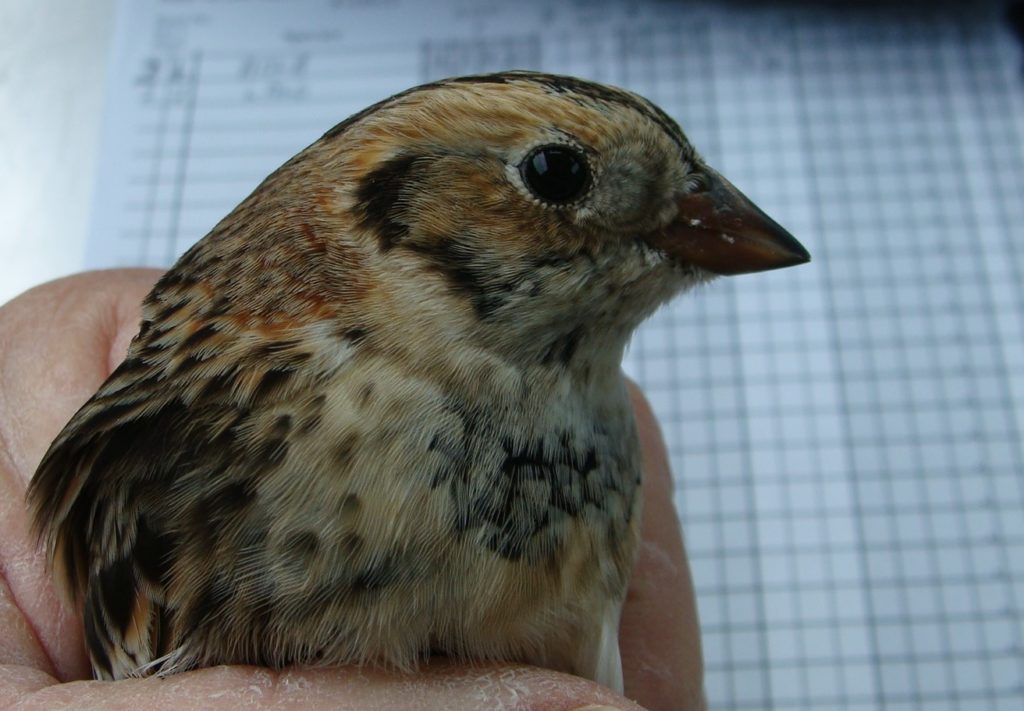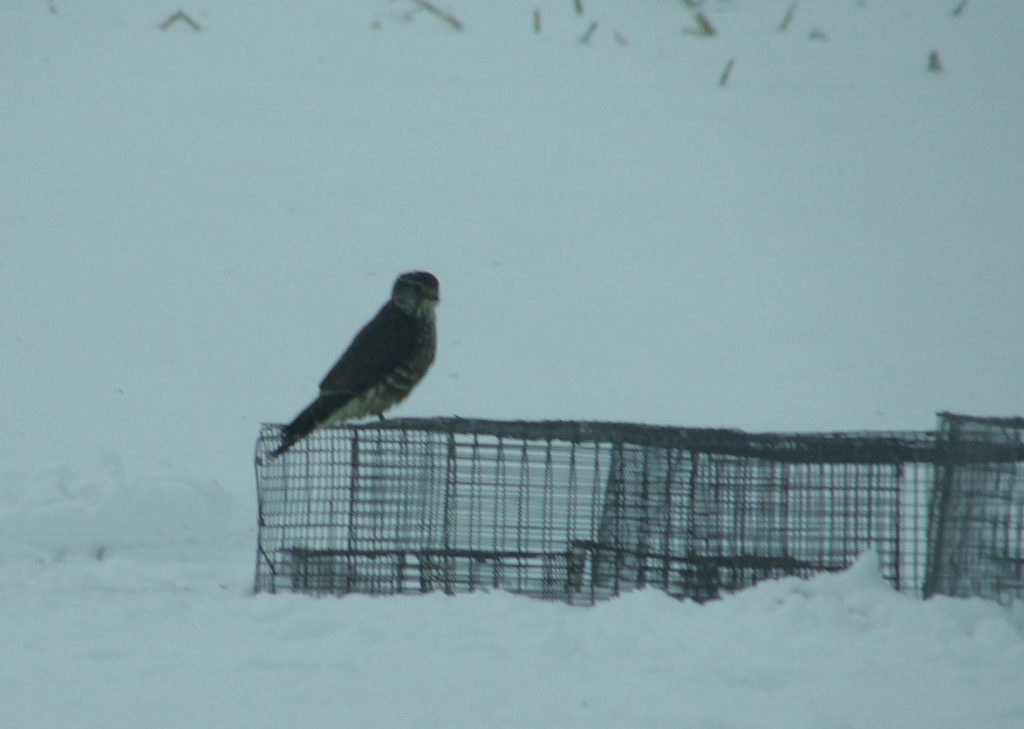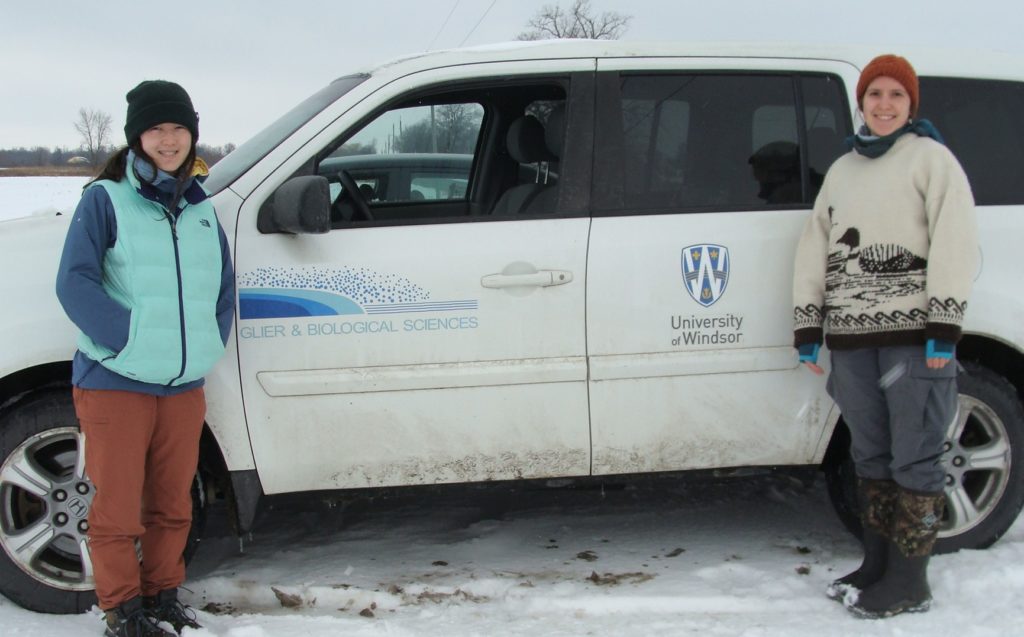
Predators pose a threat to most birds, which are often particularly vulnerable or conspicuous during foraging. (TW Sherry in Handbook of Bird Biology, Lovette and Fitzpatrick, editors)
There was a mixed flock of at least 50 birds sitting patiently over the depleted bait piles when I arrived at 7:45, waiting. They flew off a short distance, essentially nonplussed by my presence (by this time I think they’re associating me with food), and as soon as the traps were baited and as I was heading back to the car, they moved in. It was a long cold night and they were hungry. The flock was quickly joined by others , swelling the ranks to 75+ – Horned Larks, Snow Buntings and….the first Lapland Longspur of the season! A group like this, flying, hopping and walking around a small concentrated area in the middle of a white, snow-covered field completely devoid of any vegetation, is quite “conspicuous” to passing predators. I had been surprised that we hadn’t been disturbed so far. But this changed this morning!

Not more than 20 minutes after setting the traps, I noticed that this very “busy” flock had disappeared. The reason quickly became apparent when a large (probably female) Merlin flew right to the traps and tried to get at the birds inside. I was out of the car quickly to rescue them. Even as I was extracting them, hunkered down over the traps, I could hear the rush of the Merlin’s wings as it made several passes looking for escapees. After this it took half an hour before the birds began to trickle back but they were never in the same numbers as at opening.
Whenever the numbers started to build, a falcon would come dashing in scattering the feeding flock. There were at least 2 Merlins (based on relative size, likely a female and a male) and, toward the end of the morning, an American Kestrel. I was concerned about releasing banded birds as the Merlin had flown off to a treetop about 100 m. away to watch. The first bird of the day was a young male Lapland Longspur. After processing, I let it go out the window. it flew off in level flight; the Merlin responded immediately and gave chase. It made two passes at the longspur which managed to dodge the threat both times. Then the longspur resorted to a behaviour that Nancy and I had observed a number of years ago at a different site: the bird began to climb at about a 45+ degree angle. We had seen that falcons were not able to catch birds during this pursuit as they seemed to stall when trying to bring their feet up. It’s a strategy that works. The longspur continued to climb with the Merlin on its tail (almost) but the latter broke off the chase after about 20 meters and spiraled back to its treetop to watch the traps and the longspur kept flying until I couldn’t see it anymore. Whew! I didn’t see one successful hunt by the Merlins of released birds. Given the wide open habitat larks, buntings, and longspurs forage in, flocking is a good strategy. Many eyes have a greater chance to see approaching danger. And many group members, spread out over a wider expanse when travelling, are more likely to find food sources or see other birds that are feeding.

I had the pleasure of the company of two Master’s students from the University of Windsor. Both spent last Summer in the Arctic studying Snow Buntings – “Sam” and I worked together in and around Iqaluit for 5 weeks finding nests of the “Big 5”: Snow Buntings, Northern Wheatears, Lapland Longspurs, Horned Larks, and American Pipits.
When we’re banding buntings, we’ve noticed how there’s a flow of birds/flocks through a site. They feed for awhile and then take off, their place taken by other birds/flocks. This goes on through the day. When birds leave, where do they go? Do they keep moving or do they return later? How does weather affect this movement? Sam is working on these questions. She and Becky were applying little sound transmitter “backpacks” to some of the birds I was banding. It’s hoped that the array of Motus towers around the province will pick up their signals and inform us as to their movements. I’ll let you know what they find.
#2951-22529
What a treat this Snow Bunting recapture was!! I originally banded it (a young female) on February 7, 2021! in the meantime this hardy bird has flown (and nested) to the Arctic – or Greenland – twice! That’s what goes through my head when I’m holding such a traveler: what have they seen and experienced during the intervening 2 years?
Banding Results:
Yesterday: 46 Horned Larks, 19 Snow Buntings
Today: 25 Horned Larks, 15 Snow Buntings, 1 Lapland Longspur
Rick
